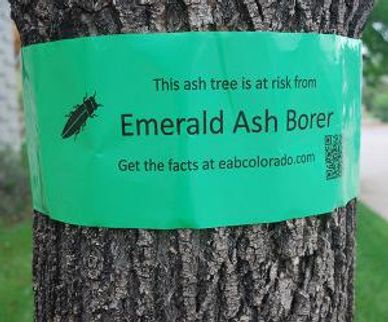Front Range Tree Treatment, LLC 720-763-4049
Common Tree Pests
Emerald Ash Borer Found in Longmont Area - In 2013, emerald ash borer (EAB) was confirmed for the first time in Colorado Foothills. This pest kills stressed and healthy trees and is so aggressive that ash trees may die within two years after they become infested. The only way to protect your ash trees is with preventative measures. Our primary way of treating ash trees is with the Arborjet system where your tree is injected with a systemic chemical that provides 2 year’s protection.
Emerald Ash Borer Found in Denver Area - In 2025 The emerald ash borer (EAB), a destructive invasive insect, has been detected in Denver, Colorado. The city confirmed the presence of EAB in the Congress Park neighborhood, putting millions of ash trees at risk. Denver is taking steps to mitigate the spread, including treating and removing infested trees and planting new, non-ash trees.



Japanese Beetle

As an adult can cause damage to foliar plants from trees and vines to potted flowers with rose blossoms as one of the most highly favored foods.

This beetle is a lawn insect in the grub stage where it feeds on the roots of grass.
Peach (Fruit) Tree Borer
Peach (Fruit) Tree Borer - This borer is the most damaging pest of peach, cherry, plum and stone fruits in Colorado. It can weaken or kill trees so preventative control is recommended. Adults bore holes in the base of the tree and roots.

Lilac Ash Borer

Damage is caused by the larvae which tunnel into the trunks and lower branches of ash trees. These feeding injuries produce irregular gouging wounds under the bark and tunneling frequently extends deeply into the heartwood. Most all untreated ash trees will show sign of this borer and it can be fatal to the tree if left untreated.
IPS Beetle
Ips beetles, sometimes known as “engraver beetles,” are bark beetles that damage pine and spruce trees. They develop under the bark and produce girdling tunnels that can cause dieback and kill trees.

Elm Leaf Beetle

The insects feed on elm leaves and cause them to dry up and die. Heavily infested leaves die and give trees an unsightly, general brown color. Repeated injuries also weaken trees and make them prone to branch dieback and wind injury
Mountain Pine Beetle
Mountain pine beetles develop in pines, particularly ponderosa, lodgepole, Scotch and limber pine. Once MPB infests a tree, nothing practical can be done to save that tree. Treatment should be done annually between April 1 and July 1 to protect high value trees.

Kermes Scale

Kermes scales occur as pests of oaks throughout the northern hemisphere. Kermes scales feed by drawing sap from the twigs (and sometimes leaves or petioles) of their hosts, which can result in growth loss, branch dieback, leaf distortion, and the accumulation of sooty mold fungi.
Aphids
Aphids are sap sucking insects often found feeding in clusters on new leaf growth. Low infestations rarely require control. High infestations can cause leaves to curl, wilt or yellow and may produce a sticky nectar that drips to the ground. A high infestation may also cause stunting of plant growth.

Shade Tree Borers - A large number of beetles and moths deve
Longhorned Beetles/Roundheaded Borers

These attack juniper, pine, spruce, fir, black locust, poplar, aspen, cottonwood, ash and other hardwoods. There are many types of longhorned beetles, typically characterized by extremely long antennae.
Metallic Wood Borers/Flatheaded Borers

These attack ash, apple, maple, birch, juniper, most hardwoods and poplar species of trees. The Emerald Ash Borer is included in this group of borers typically recognized by short antennae, oval body shape and iridescent coloring.
Clearwing Borers

host species of trees include alder, ash, birch, dogwood, lilac, hawthorn, mountain ash, maple, oak, pine, poplar, sycamore, viburnum, willow and fruit trees such as apricot, cherry, peach and plum. This group of borers include ash/lilac borer, peach tree borer, raspberry crown borer, viburnum borer and currant borer.
Pinyon Borers

These include pinyon pitch mass borer and Zimmerman pine moth. Larvae of this group of moths cause problems to various pines. Most common is the pinyon pitch mass borer that causes large masses of pitch to form around feeding wounds under the bark of trunks and branches.
The Zimmerman pine moth is a more recently established species of borer. It attacks the branch crotches of Austrian pine, causing branches to break easily. Presently outbreaks exist in parts of Denver and Boulder.
Horntails

Horntails are a family of nonstinging wasps (sawflies) that develop solely within trunks and branches of trees. Horntails can attack both hardwoods and conifers.
Carpenterworms

Hosts include oak, elm, maple, willow, cottonwood, black locust, boxelder, sycamore, and ash, but the insect exhibits regional host preferences. In the Rocky Mountain Region, poplars are the major hosts in the mountain areas.
Copyright © 2025 Front Range Tree Treatment - All Rights Reserved.
This website uses cookies.
We use cookies to analyze website traffic and optimize your website experience. By accepting our use of cookies, your data will be aggregated with all other user data.